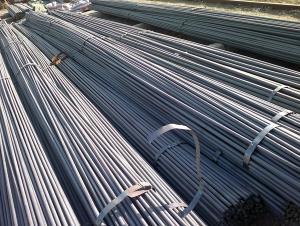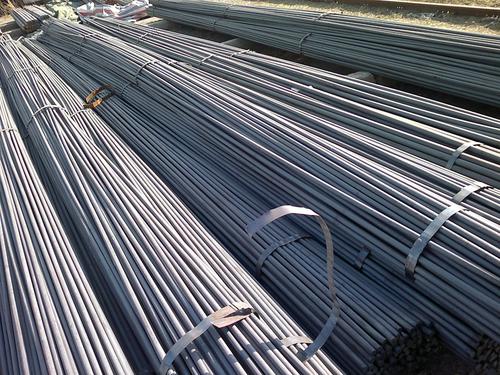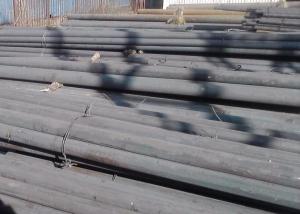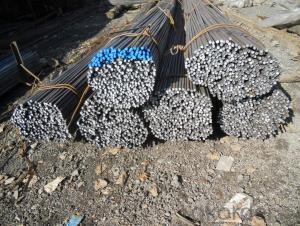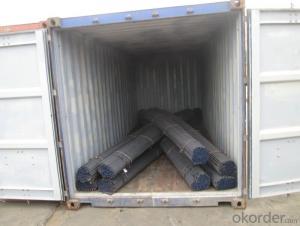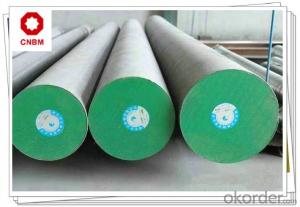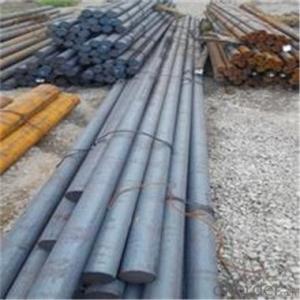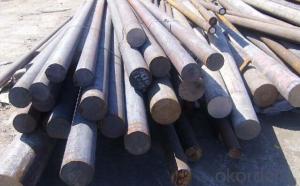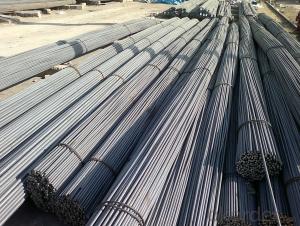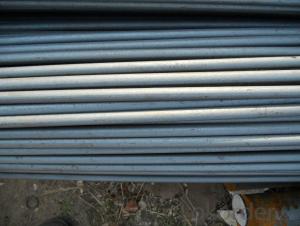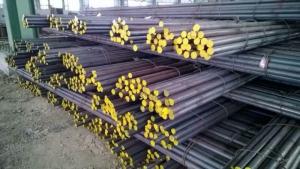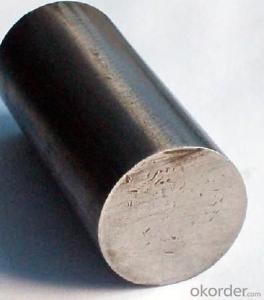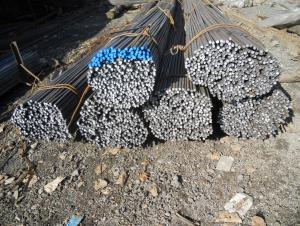High-Quality Round Bar
- Loading Port:
- China Main Port
- Payment Terms:
- TT OR LC
- Min Order Qty:
- -
- Supply Capability:
- -
OKorder Service Pledge
OKorder Financial Service
You Might Also Like
Specifications of High Quality Round Bar
1. Grade: GB, JIS, ASTM, EN
2. Grade: Q235, SS400, A36, S235JR
3. Diameter and mass: As below
Diameter | Mass | Diameter | Mass | Diameter | Mass |
(mm) | (kg/m) | (mm) | (kg/m) | (mm) | (kg/m) |
6 | 0.22 | 22 | 2.98 | 53 | 17.30 |
7 | 0.30 | 24 | 3.55 | 56 | 19.30 |
8 | 0.40 | 25 | 3.85 | 60 | 22.20 |
9 | 0.50 | 26 | 4.17 | 63 | 24.50 |
10 | 0.62 | 28 | 4.83 | 65 | 26.00 |
11 | 0.75 | 30 | 5.55 | 70 | 30.20 |
12 | 0.89 | 32 | 6.31 | 75 | 34.70 |
13 | 1.04 | 34 | 7.13 | 80 | 39.50 |
14 | 1.21 | 36 | 7.99 | 85 | 44.50 |
15 | 1.39 | 38 | 8.90 | 90 | 49.90 |
16 | 1.58 | 40 | 9.86 | 95 | 55.60 |
17 | 1.78 | 42 | 10.90 | 100 | 61.70 |
18 | 2.00 | 45 | 12.50 | 120 | 88.85 |
19 | 2.23 | 48 | 14.20 | 140 | 120.93 |
20 | 2.47 | 50 | 15.40 | 150 | 138.82 |
4. Material: Mild Steel
5. Heat treatment of high quality steel:
Fire: Isothermal annealing temperature is 800 ~ 880 °C, with 10 ~ 20 °C, the furnace cooling to about 600 °C, hardness above HB269.
Preheat temperature: 730-730 °C
Quenching temperature: 1190-1210 °C
Tempering temperature: 540-595 °C
Cold drawn, hardness 285 HBS
Cold drawn after annealing condition, hardness 277 HBS
Quenching methods: oil quenching, air cooling or salt bath quenching
Usage and Applications of High Quality Round Bar
1) Suitable for making various strong cutting tool abrasion resistance, impact resistance.
2) Used to produce all kinds of high hard and super hard saw blade, drill, tap, broach, gear hob and various kinds of milling cutter.
3) Used for advanced punching die, screw die, and the toughness and complicated shape of the punch, etc.
4) Is used for cold forging die and drawing mode, etc.
5) Recommended watchcase factory, screw factory and other cold stamping products industry use.
Packaging & Delivery of High Quality Round Bar
Packaging Detail: All goods are packed in bundle with steel strips and shipped by break bulk vessel or container (depend on target market and different ports)
Delivery Detail: 45 days
Trade terms: FOB, CFR, CIF
MOQ: 25 tons per specification; we can negotiate the quantity if the specification is normal or we have stock of one specification.
Weight: The price invoicing on theoretical weight basis or actual weight basis depends on customer’s request.
Shipment: The shipment of bulk break or container is depends on customer’s request and the situation of the port of destination.
Documents given: Full set of original clean on board bill of lading; Original signed commercial invoice; Original packing list; Policy of insurance; Certificate of origin and what the target market needs.
Production Flow of High Quality Round Bar
The common processes are preheated forging quenching, dual refinement solution process, cooling quenching and isothermal quenching. We use heat treatment for dual refinement solution process. The main measures process is high temperature solution and refinement cycle. High temperature solution can improve the carbide morphology and particle size. The aim is to make the loop refinement ultrafine austenite grains.
- Q: The difference between 304 stainless steel round bar and bright round bar
- The difference between the stainless steel round bar and the bright round steel of the same material is that the bright circle is cold rolled (or cold drawn), and the black circle is hot rolledThe processing method is different
- Q: Can steel round bars be used in the telecommunications industry?
- Indeed, the telecommunications industry can make effective use of steel round bars. These bars are frequently employed to offer structural reinforcement for a range of telecommunications equipment, including antennas, satellite dishes, and communication towers. Notably resilient, these bars can withstand adverse weather conditions, rendering them well-suited for outdoor installations. Furthermore, the ease with which steel round bars can be fabricated and molded to meet precise design specifications enables the seamless integration of diverse components within the telecommunications infrastructure.
- Q: What are the different methods of cutting steel round bars?
- Cutting steel round bars can be achieved through several methods, each with their own advantages and limitations. Among the commonly utilized techniques are: 1. Abrasive cutting: By utilizing a rotating abrasive wheel, the steel round bar can be ground down. Despite its speed and efficiency, this method often results in a rough cut surface and generates significant heat. 2. Bandsaw cutting: Steel round bars can be sliced using bandsaw machines, which feature a continuous band of toothed metal rotating around two wheels. Although bandsaws provide precise and smooth cuts, they tend to be slower compared to alternative methods. 3. Cold saw cutting: Cold saws are designed specifically for cutting metal, including steel round bars. These saws employ circular blades with teeth that are specially crafted to withstand the hardness of steel. While cold saws guarantee clean and accurate cuts, they generally operate at a slower pace than abrasive or bandsaw cutting. 4. Plasma cutting: Ideal for thicker steel round bars, plasma cutting involves using a focused jet of ionized gas to melt and remove the metal. This method yields precise and clean cuts, but necessitates specialized equipment and can be more costly than other techniques. 5. Laser cutting: Laser cutting employs a high-powered laser beam to melt and vaporize the metal, resulting in precise and clean cuts. This versatile method can be utilized for steel round bars of varying thicknesses, but it does require expensive equipment and may not be suitable for all applications. Ultimately, the chosen cutting method relies on several factors, including the thickness and hardness of the steel round bar, the desired cut quality, the availability of equipment, and the specific project requirements.
- Q: How are steel round bars used in the manufacturing of hydraulic systems?
- Steel round bars are commonly used in the manufacturing of hydraulic systems due to their strength, durability, and versatility. These bars serve various purposes in the construction and assembly of hydraulic components. One primary use of steel round bars in hydraulic systems is for the fabrication of piston rods. Piston rods are crucial components of hydraulic cylinders, responsible for transferring the force generated by the hydraulic fluid to the desired mechanism. The high strength and rigidity of steel round bars make them ideal for this application, as they can withstand the intense pressure and stress exerted on the piston rod during operation. Steel round bars are also utilized in the manufacturing of shafts and axles within hydraulic systems. These components are responsible for transmitting rotational motion and torque from the hydraulic pump to other mechanical parts, such as gears or pulleys. By using steel round bars, manufacturers can ensure the reliability and longevity of these critical parts, as they possess excellent mechanical properties and resistance to wear and tear. Additionally, steel round bars are often employed in the construction of hydraulic fittings and connectors. These components are responsible for joining different hydraulic pipes, hoses, or valves together, creating a sealed system for fluid transmission. Steel round bars provide the necessary strength and stability to withstand the high-pressure conditions within hydraulic systems, ensuring leak-free operation and the efficient transfer of fluids. In summary, steel round bars play a vital role in the manufacturing of hydraulic systems by providing strength, durability, and versatility. Their use in piston rods, shafts, axles, fittings, and connectors ensures the proper functioning and reliability of these systems.
- Q: Can steel round bars be used for making conveyor belts?
- No, steel round bars are not suitable for making conveyor belts as they lack the necessary flexibility and surface properties required for effective and efficient conveyor belt operation. Conveyor belts are typically made from materials such as rubber or synthetic fabrics that provide durability, grip, and flexibility to facilitate the movement of goods.
- Q: Can steel round bars be used as axles or shafts?
- Yes, steel round bars can be used as axles or shafts due to their high strength, durability, and ability to withstand heavy loads and torque. They are commonly used in various industries such as automotive, marine, and construction for their excellent mechanical properties and reliability.
- Q: What are the different types of corrosion-resistant steel round bars?
- In the market, one can find a variety of corrosion-resistant steel round bars. The most commonly used types are as follows: 1. Stainless Steel Round Bars: Stainless steel is a popular choice when it comes to applications that require resistance to rust and corrosion. Its high resistance stems from the presence of chromium, which creates a protective oxide layer on the steel's surface, effectively preventing further corrosion. 2. Duplex Stainless Steel Round Bars: Duplex stainless steel is a unique type of stainless steel that combines austenite and ferrite microstructures in a balanced manner. This combination grants it exceptional corrosion resistance, high strength, and excellent weldability. 3. Nitronic Stainless Steel Round Bars: Nitronic stainless steel is an alloy known for its exceptional performance. It offers superior corrosion resistance, high strength, and good ductility. The presence of nitrogen further enhances its ability to resist pitting and crevice corrosion. 4. Alloy Steel Round Bars: Alloy steel refers to steel that has been alloyed with various elements in order to enhance its properties. Some alloy steels, including corrosion-resistant alloys (CRA), are specifically designed to withstand corrosion in harsh environments. These alloys typically contain elements such as chromium, nickel, and molybdenum. 5. Aluminum Round Bars: Although not technically steel, aluminum round bars are commonly used in applications where corrosion resistance is crucial. Aluminum forms a protective oxide layer on its surface, effectively preventing corrosion. It is particularly suitable for applications where weight is a concern. 6. Copper-Nickel Round Bars: Copper-nickel alloys, such as Cu-Ni 90/10 and Cu-Ni 70/30, are extensively utilized in marine and offshore applications due to their excellent resistance to seawater corrosion. These alloys possess high strength, good ductility, and exceptional resistance to biofouling. These examples represent only a fraction of the corrosion-resistant steel round bars available in the market. The choice of material depends on specific application requirements, environmental conditions, and budget considerations. Consulting a materials engineer or specialist is crucial in selecting the most suitable corrosion-resistant steel round bar for a particular application.
- Q: Are steel round bars suitable for bicycle frame applications?
- Yes, steel round bars are suitable for bicycle frame applications. Steel is a popular material choice for bicycle frames due to its strength, durability, and versatility. Steel round bars provide excellent structural integrity, making them ideal for supporting the weight and stress placed on a bicycle frame during use. Additionally, steel is known for its high fatigue resistance, which means it can withstand repeated loading and unloading without losing its strength. Steel round bars also offer good weldability, allowing for easy construction and repair of bicycle frames. Overall, steel round bars are a reliable and practical choice for bicycle frame applications.
- Q: Three - grade thread Phi 10 steel can replace a grade Phi 12 round bar? Which elder knows, trouble pointing.
- According to the substitution of steel bars, one method, equal strength substitution, equal area substitution and equal root substitution can be obtained by substitution. Three grades of thread Phi 10, steel replaced by a grade Phi 12 of the round steel, I think it may appear: does not meet the minimum reinforcement ratio requirements and reinforcement construction regulations. Don't change it for the best. But must change, must pass the design.
- Q: How strong are steel round bars compared to other materials?
- Steel round bars, renowned for their exceptional strength and durability, are widely recognized as one of the toughest materials available. In comparison to aluminum, brass, and wood, steel round bars boast a significantly higher tensile strength, referring to their capacity to withstand pulling forces without succumbing to breakage. Moreover, steel round bars are capable of handling higher compressive loads, rendering them highly suitable for applications involving substantial pressure or heavy loads. Not only do steel round bars exhibit remarkable strength, but they also showcase excellent ductility, allowing for easy shaping and bending without any risk of fracture. This remarkable feature grants steel round bars versatility, which explains their extensive utilization in diverse industries such as construction, automotive, manufacturing, and aerospace. While other materials possess their own distinctive properties and applications, steel round bars consistently remain the preferred choice in terms of strength and reliability. Their ability to endure high loads, resist deformation, and maintain structural integrity positions them as a favored option for structural components, shafts, axles, and various other demanding applications.
Send your message to us
High-Quality Round Bar
- Loading Port:
- China Main Port
- Payment Terms:
- TT OR LC
- Min Order Qty:
- -
- Supply Capability:
- -
OKorder Service Pledge
OKorder Financial Service
Similar products
Hot products
Hot Searches
Related keywords
